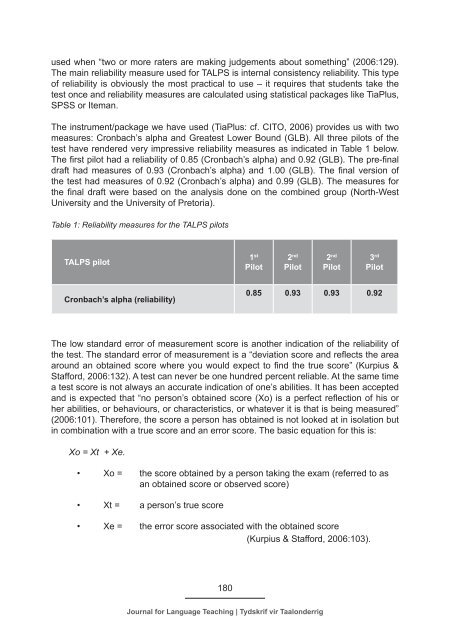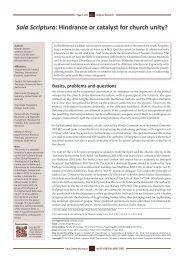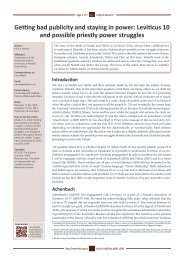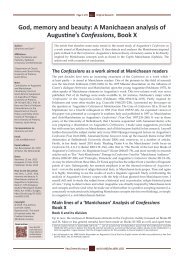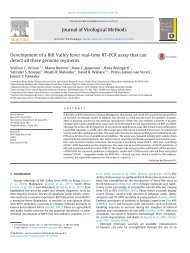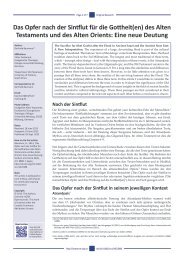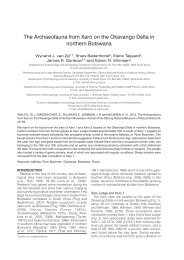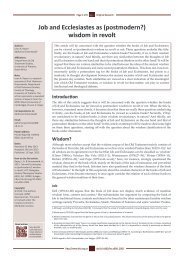View/Open - University of Pretoria
View/Open - University of Pretoria
View/Open - University of Pretoria
Create successful ePaper yourself
Turn your PDF publications into a flip-book with our unique Google optimized e-Paper software.
used when “two or more raters are making judgements about something” (2006:129).<br />
The main reliability measure used for TALPS is internal consistency reliability. This type<br />
<strong>of</strong> reliability is obviously the most practical to use – it requires that students take the<br />
test once and reliability measures are calculated using statistical packages like TiaPlus,<br />
SPSS or Iteman.<br />
The instrument/package we have used (TiaPlus: cf. CITO, 2006) provides us with two<br />
measures: Cronbach’s alpha and Greatest Lower Bound (GLB). All three pilots <strong>of</strong> the<br />
test have rendered very impressive reliability measures as indicated in Table 1 below.<br />
The first pilot had a reliability <strong>of</strong> 0.85 (Cronbach’s alpha) and 0.92 (GLB). The pre-final<br />
draft had measures <strong>of</strong> 0.93 (Cronbach’s alpha) and 1.00 (GLB). The final version <strong>of</strong><br />
the test had measures <strong>of</strong> 0.92 (Cronbach’s alpha) and 0.99 (GLB). The measures for<br />
the final draft were based on the analysis done on the combined group (North-West<br />
<strong>University</strong> and the <strong>University</strong> <strong>of</strong> <strong>Pretoria</strong>).<br />
Table 1: Reliability measures for the TALPS pilots<br />
TALPS pilot<br />
1 st<br />
Pilot<br />
2 nd<br />
Pilot<br />
2 nd<br />
Pilot<br />
3 rd<br />
Pilot<br />
Cronbach’s alpha (reliability)<br />
0.85 0.93 0.93 0.92<br />
The low standard error <strong>of</strong> measurement score is another indication <strong>of</strong> the reliability <strong>of</strong><br />
the test. The standard error <strong>of</strong> measurement is a “deviation score and reflects the area<br />
around an obtained score where you would expect to find the true score” (Kurpius &<br />
Stafford, 2006:132). A test can never be one hundred percent reliable. At the same time<br />
a test score is not always an accurate indication <strong>of</strong> one’s abilities. It has been accepted<br />
and is expected that “no person’s obtained score (Xo) is a perfect reflection <strong>of</strong> his or<br />
her abilities, or behaviours, or characteristics, or whatever it is that is being measured”<br />
(2006:101). Therefore, the score a person has obtained is not looked at in isolation but<br />
in combination with a true score and an error score. The basic equation for this is:<br />
Xo = Xt + Xe.<br />
• Xo = the score obtained by a person taking the exam (referred to as<br />
an obtained score or observed score)<br />
• Xt = a person’s true score<br />
• Xe = the error score associated with the obtained score<br />
(Kurpius & Stafford, 2006:103).<br />
180<br />
Journal for Language Teaching | Tydskrif vir Taalonderrig


